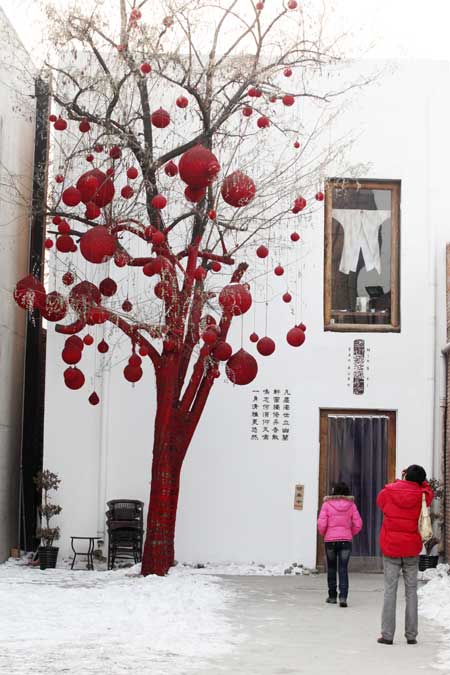Creative gardens bloom
|
|
|
A corner of the 798 Artistic District in Beijing. [GLobal Times] |
As China prepares for the upcoming "golden" decade of cultural industry development, numerous creative gardens, regarded by many as an efficient way to promote the industry, have been enjoying a boom, including the announcement earlier this month of a new 15 billion yuan (US$2.3 million) project.
Construction of the Songshan Lake Garden in Songshan Lake district, Dongguan, Guangdong Province, will begin later this year, according to Songshan Lake Business Development Bureau.
The international garden will be built as the first digital multimedia industry colony in China, with animation at its core. A business chain of related industries will be developed and the initial phase will span over 121 hectares.
Songshan Lake district currently has 36 creative enterprises, spurring the local government to capitalize on boosting its creative industry, according to Songshan Lake Management Committee.
The committee revealed that all of the 36 enterprises will be included in the new garden and that a package of supportive measures will be adopted to attract more largescale creative enterprises from around the country, including discounted rent and supporting infrastructure.
Creative zones in other parts in China are also emerging, with major cities such as Beijing and Shanghai leading the charge. Beijing now has 21 creative gardens, among which 11 have been established in the last two years. Shanghai boasts more than 70 creative gardens.
Late last year Beijing Municipal Government announced an annual funding grant of 100 million yuan (US$15 million) to support China Animation Game City, which will be established on the old site of Beijing Shougang Machinery & Electric Company. Construction is currently underway and once complete, the park will cover 1.2 million square meters. Deputy cultural minister Ouyang Jian said that the center will rival Disneyland.
There are over 500 creative gardens in China, most of which are themed on art and design, new media, film, performing arts and various entertainment genres, according to a report conducted by Peking University.
Although many of the gardens have achieved a lot in terms of helping to boost related local cultural industries such as tourism and creative industries, there are still many problems that need to be addressed, according to Fu Caiwu, director of the National Cultural Innovation Research Center at Wuhan University. Fu said that one of the many problems is the lack of creative talents in the creative gardens, saying that talented people are essential in building an efficient creative area. "We have numerous college students graduate each year, but there is still a lack of highend creative talents."
There are two modes of creative gardens in China, according to Zhang Sanxi, professor at the Literature School of Central China Normal University. Some emerge naturally from the grass roots as artists establish themselves in close and nurturing environments, such as the 798 and Songzhuang art districts in Beijing, Xiaozhou Art Village in Guangzhou and Moganshan Art Zone in Shanghai. Others are constructed under administrative orders from the government, with the latter often lacking vital energy.
Compared with naturally emerging art districts, where artists and creative people enjoy their environment, creative gardens founded and run by the government do not tend to attract a similar type of person, as artists and creative talents generally prefer to work in a more free atmosphere, Fu explained.
Today even successful creative areas such as the 798 Artistic District in Beijing and Blueroof Art Center in Chengdu are facing a "brain drain" as the areas have become classified as important creative gardens by local governments and artists are forced to move out due to soaring rent prices and a loss of ad hoc creative development.
Professor Wang Jici from the Department of Urban and Economic Geography at Peking University told the Global Times that another problem is the mistaken concept that when talking about building creative gardens, attention is often drawn to making instant money, rather than fostering talent in the long term.
Wang added that a quiet space as well as sufficient time and money should be provided for artists, but most government officials take building creative gardens as a political achievement, seldom considering further funding after they are established.
"Some creative gardens are now almost empty, as both creative enterprises and talents have been scared away by the sky-high property prices there," Wang said, adding that the government should make efforts to maintain vitality within established creative gardens and not keep spending money on building more.
 0
0 







